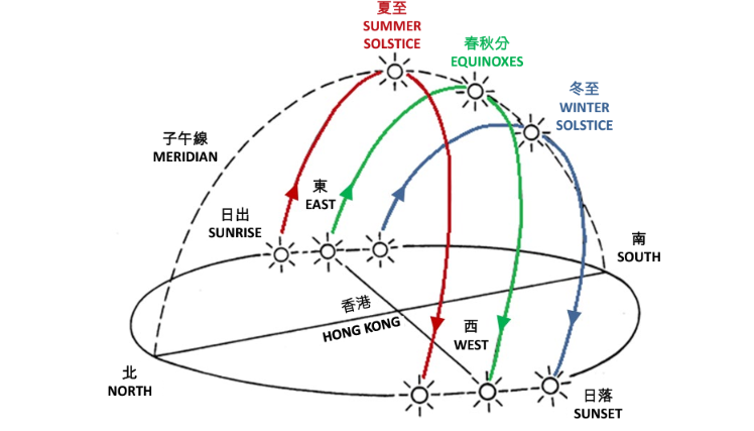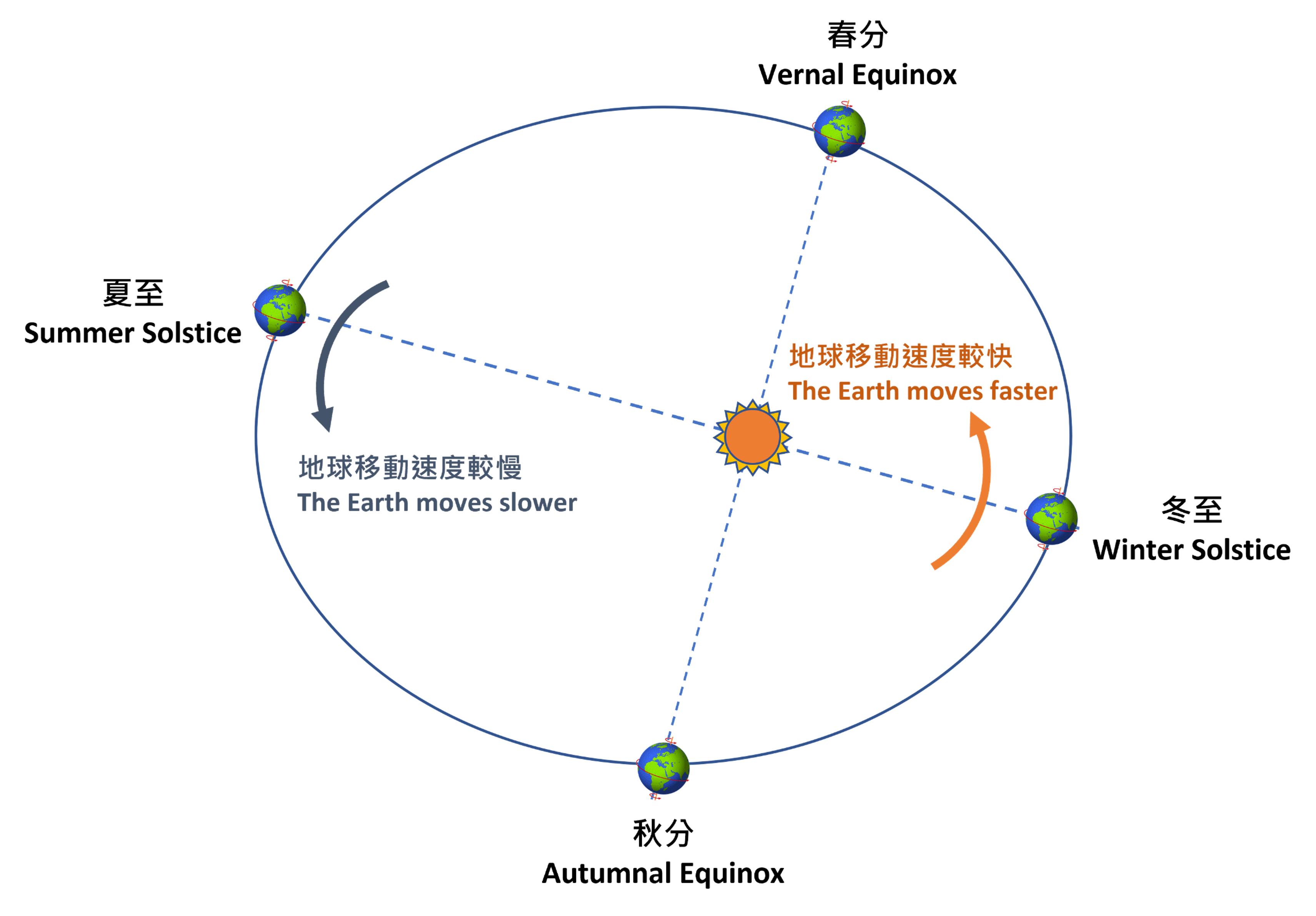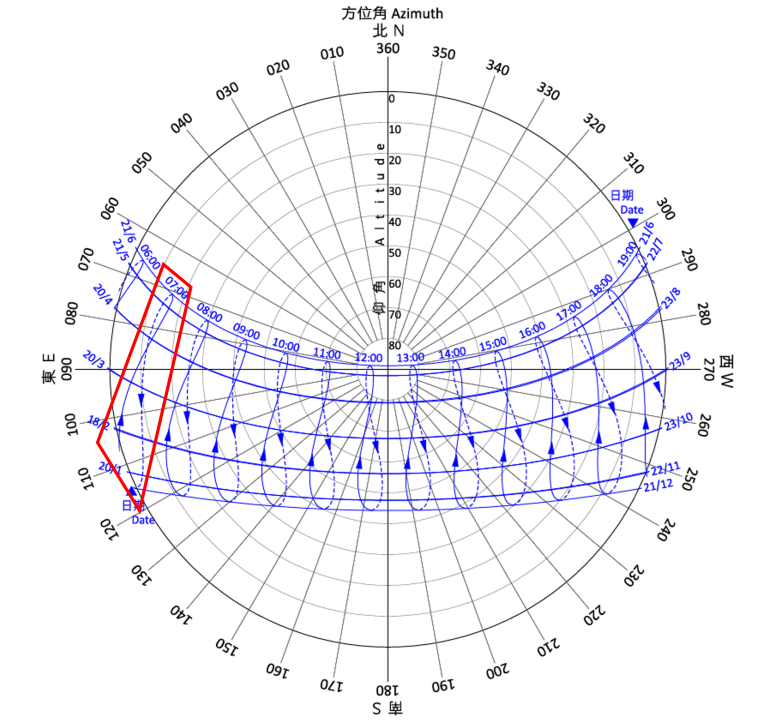Understanding the Sun Path: The Figure “8” in the Sky!
Understanding the Sun Path: The Figure “8” in the Sky!
CHAN Wai-soen
June 2025
Have you ever noticed that the times of sunrise are different in summer and winter? In summer, the Sun rises earlier, while in winter, it rises later. Figure 1 is a collection of six photographs taken at the same time on different days. The sun rises around seven o'clock local time around December, while in June, the Sun is already high in the sky at that time. In fact, the Sun rises at slightly different times and positions each day, following a fixed pattern that repeats annually.

Figure 1 Observatory’s weather photos taken from Clear Water Bay facing east at the same time (7:10 AM Hong Kong Time) on different days (with dates marked in black) in 2024[Note].
The Tilt of the Earth's Axis
The Earth's rotation axis is tilted about 23.5 degrees. During the Earth's annual revolution, the Sun is directly above the equator during the vernal and autumnal equinoxes, resulting in nearly equal lengths of day and night. From the vernal equinox to the autumnal equinox, the northern side of the Earth’s axis tilts toward the Sun (Figure 2). Since Hong Kong is located in the Northern Hemisphere, the Sun rises near the northeast, and the sunrise occurs earlier (Figure 3). After the autumnal equinox, the situation reverses, with the Sun rising near the southeast in the Northern Hemisphere, and the sunrise occurring later.

Figure 2 During the summer in the Northern Hemisphere, the tilt of the axis allows longer daytime than nighttime.

Figure 3 A simple path diagram of the Sun observed in Hong Kong showing the annual variation in the position of the sunrise.
The Earth's Elliptical Orbit
The Earth's orbit around the Sun is not a perfect circle; it is elliptical (Figure 4). Therefore, the speed of the Earth's movement varies at different times of the year. When the Earth is closer to the Sun, it moves faster; when it is farther from the Sun, it moves slower. In other words, this causes the Sun's apparent position in the sky at the same time to vary each day throughout the year.

Figure 4 A schematic diagram illustrating the Earth’s elliptical orbit around the Sun, showing the approximate positions of the Earth at the Vernal Equinox, Summer Solstice, Autumnal Equinox and Winter Solstice. (The diagram is for illustration purpose only. The Sun and the Earth are not drawn to scale.)
Because the Earth's rotation axis is tilted, if you observe the Sun's position at the same time and location each day for an entire year, you could see the Sun's positions forming a figure "8"! It can be seen from the composite Observatory’s weather photo in Figure 5 that the figure “8” is asymmetrical. This is because the Earth’s orbit is elliptical. This “8” shaped path is called the solar path. The top of the solar path (orange dot on Figure 5) corresponds to the longest day of the year (the Summer Solstice), while the bottom (blue dot on Figure 5) corresponds to the shortest day of the year (the Winter Solstice).

Figure 5 A composite Observatory’s weather photo taken from Clear Water Bay at 7:10 AM Hong Kong Time on different days (16 clear-sky mornings selected) in 2023 [Note]. The dashed line marks the solar path, indicating the varying positions of the Sun as seen at the same time but on different days throughout the year.
The shape of the Sun path varies slightly depending on the observer's location. The Sun's position as seen from Hong Kong throughout the year is available in the Hong Kong Observatory Almanac published by the Observatory on its website (Figure 6).

Figure 6 Sun Path Diagram calculated at the location of the Hong Kong Observatory. The red box indicates the sun path at 7:00 a.m., a time close to that in Figure 4.
Note:
Due to the camera's exposure settings, the Sun on the left appears larger. In reality, the apparent diameter of the Sun as observed from the Earth is about 0.53 degrees, and its annual variation is little. Additionally, the horizontal flare above the Sun is caused by optical phenomena of the camera.
Due to the camera's exposure settings, the Sun on the left appears larger. In reality, the apparent diameter of the Sun as observed from the Earth is about 0.53 degrees, and its annual variation is little. Additionally, the horizontal flare above the Sun is caused by optical phenomena of the camera.